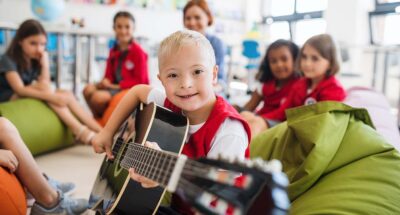
Music to Inspire Kindness
Students will make music with others (e.g., classmates, teachers, larger school) to encourage generosity and helping behavior.

Students will make music with others (e.g., classmates, teachers, larger school) to encourage generosity and helping behavior.
Students will:
There are many ways we can inspire our students to be kind—from the way we talk to them to how we acknowledge them to the stories we read together. But there is another easy way to encourage kindness in children: with music.
Sara Beck, Ph.D., Randolph College
Research suggests that joint music-making can inspire children to be generous afterward. In one study, preschoolers between three and six years old were randomly assigned to one of two play activities. In the musical activity, one of the researchers sang a simple song and invited the child and another researcher to sing along and sway to the music. In the other activity, the researcher simply recited the song lyrics as a poem. During both activities, the researcher invited the child and the other researcher to play with shakers (percussion instruments).
Researchers found that children who participated in the sing-along activity shared their stickers more often—and spontaneously helped the researchers when compared to the other group of children.
Kindness is good for kids. School-age children who engage in kind acts benefit—they are more well-liked by their peers and have improved well-being. The benefits of kindness are even seen as early as toddlerhood—young children are happier when giving to others than when receiving.
As teachers and school leaders, we want to see our students be kind at school. But the practice of sharing and helping can sometimes be challenging for young children because their perspective-taking skills and impulse-control abilities are still developing.
Singing and making music together can foster connection and kindness between people, even if they have just met. And if you facilitate this practice with someone new to your classroom or school (e.g., a new student or a new teacher/school administrator), they may have more positive “first impressions” of each other that could lead to stronger relationships in the future.

Do you want to dive deeper into the science behind our GGIE practices? Enroll in one of our online courses for educators!
Comments